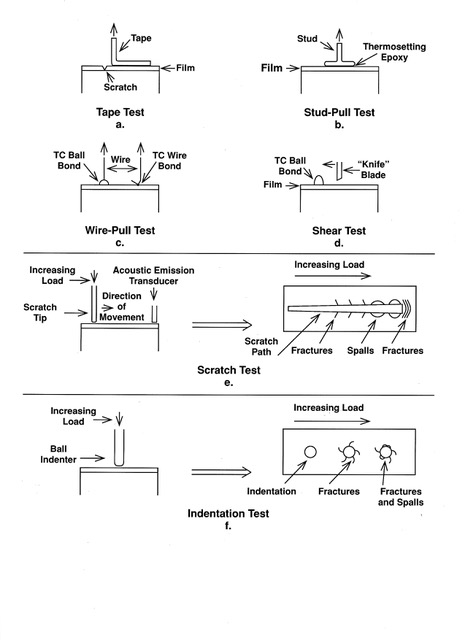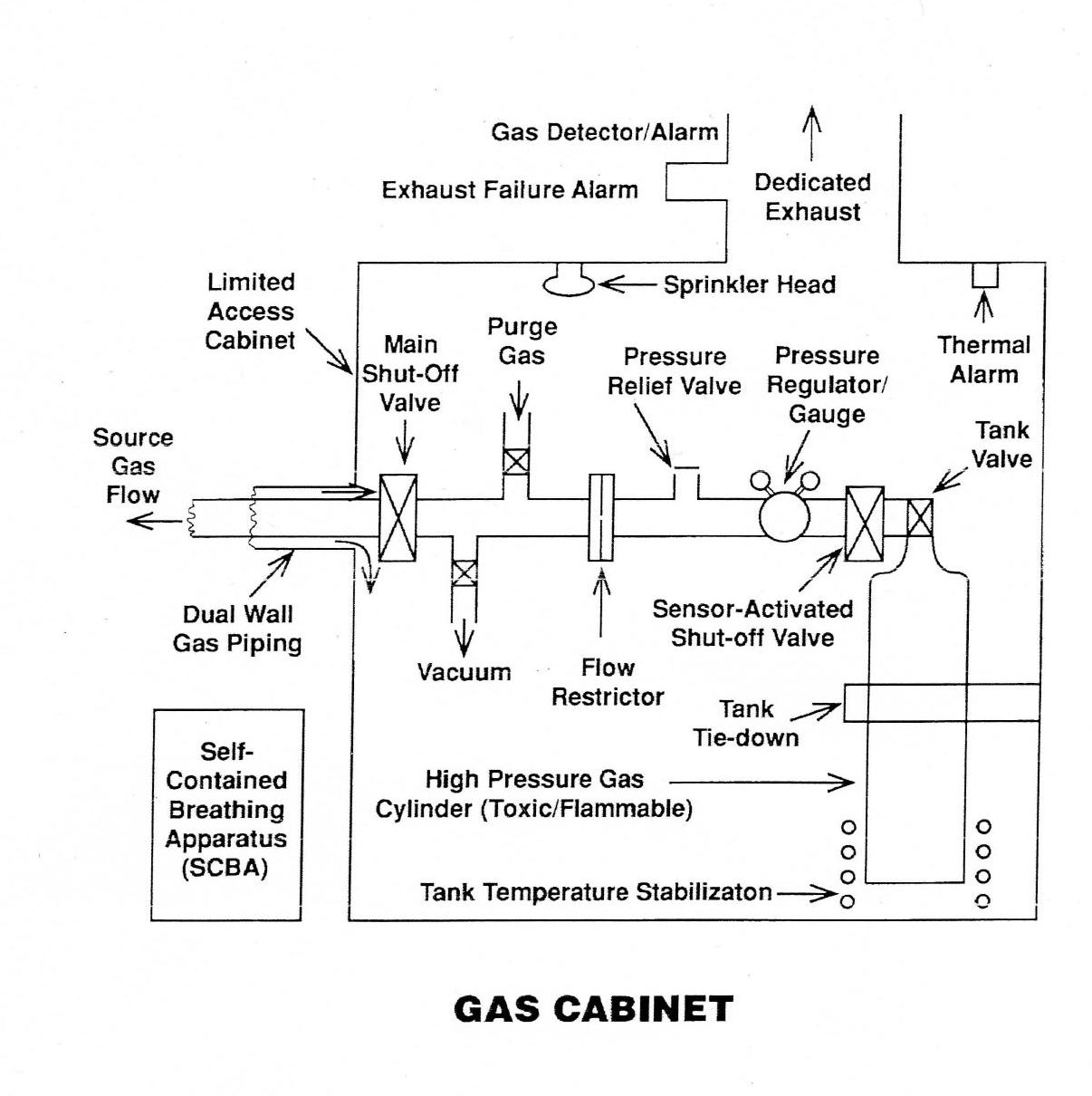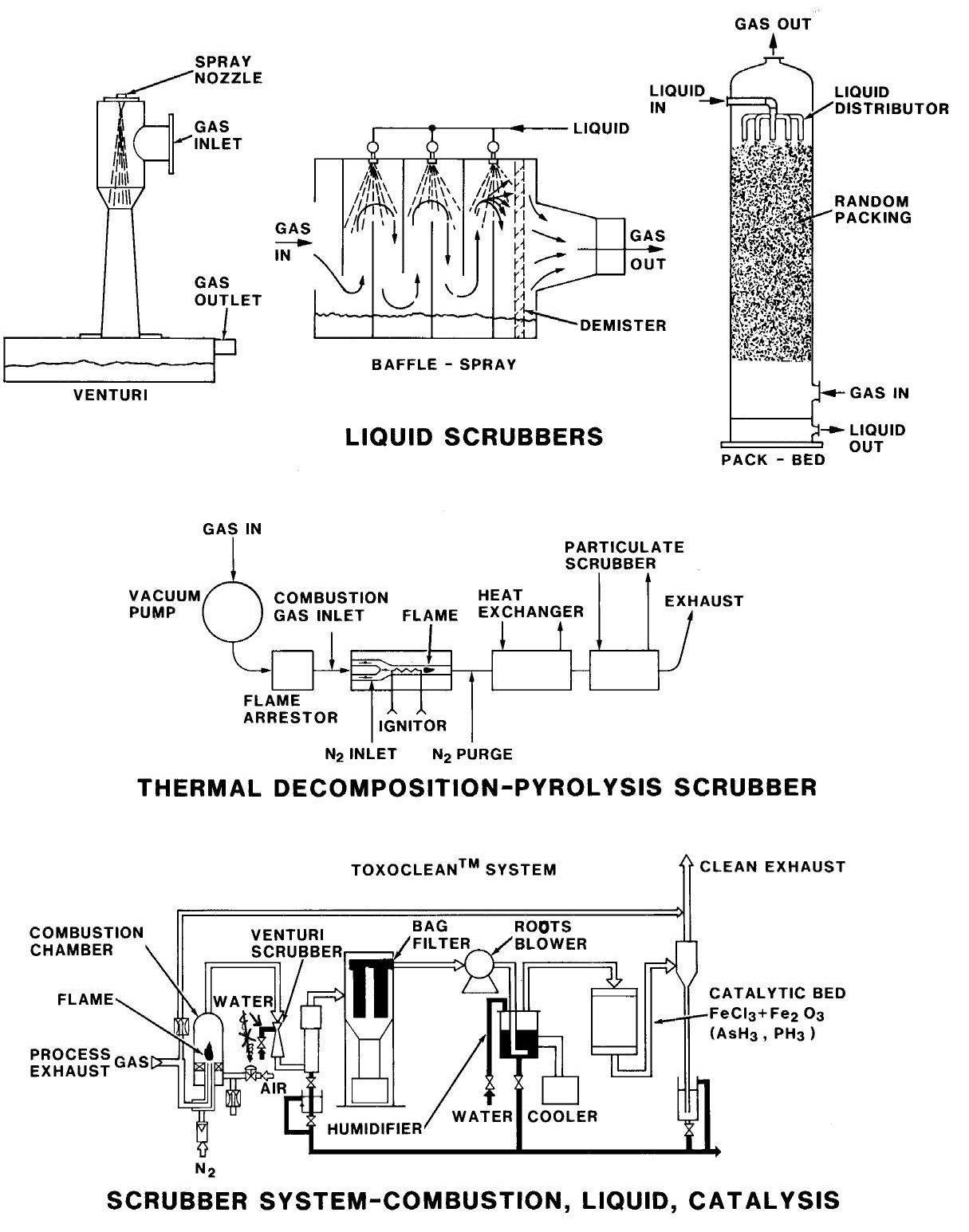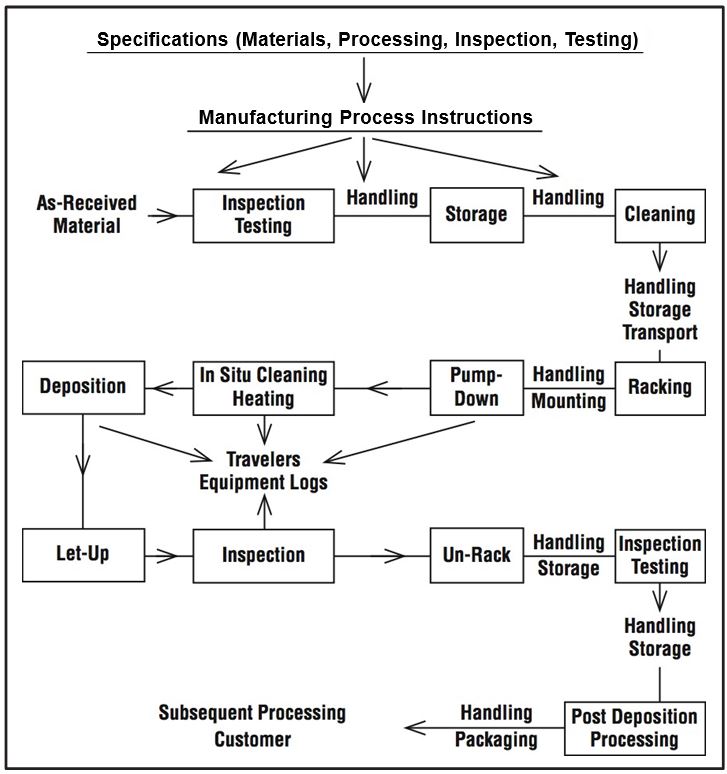Author: Donald M. Mattox
The condensation/nucleation of depositing atoms (“adatoms”) on the surface is important in determining the adhesion/deadhesion at the interface or in the near-interface material [1,2]. The atoms nucleate on a surface by one of three modes as defined by E. Bauer in 1958 [3].
- Volmer-Weber (V-W) model. In the V-W model adatoms move over the surface and form isolated islands that grow three dimensionally before they join, possibly leaving voids at the interface. The nucleation may be random due to adatom collisions on the surface or may be associated with “preferential nucleation” sites. In some cases the poor bonding allows the liquid-like nuclei to move over the surface. This gives rise to the so called “island-channel-film” growth mode.
- Frank-van der Merwe (F-vdM) model – This model is also called the “layer-by-layer” growth model. In the F-vdM model adatoms form continuous layers on the surface with low numbers of adatoms as a result of a high nucleation density.
- Stranski-Krastanov (S-K) model – This model of growth is also called the “layer plus island” growth model. In S-K the first several monolayers of the adatoms that are condensed on the surface change the composition and/or structure of the surface. This changes the properties of surface to become less conducive to layer growth and more conducive to island growth (i.e. V-W type growth) which is favorable to some forms of nanotechnology that use isolated islands on a surface.
Bauer’s classification applies to epitaxial growth* of atomistically deposited films on a substrate, where diffusion at the interface is not desirable. For understanding film/substrate adhesion we need to add another nucleation mode where there is adatom reaction or mixing with the surface layer that makes the surface more conducive to high density nucleation and subsequent diffusion. If there is diffusion the reaction/mixing front may move laterally as well as normal to the surface.
* Epitaxy means the oriented growth of a crystal film on a crystalline substrate where the crystalline orientation of the film is determined by the orientations in the substrate surface. The term epitaxy comes from the Greek roots epi (ἐπί), meaning “above”, and taxis (τάξις), meaning “an ordered manner.” Epitaxial growth of single crystal films is important in the semiconductor industry.
As condensation continues, the interface between the film and substrate may or may not change due to interdiffusion and chemical reaction. The general types of interfacial regions are: 1) an abrupt transition of composition and properties, 2) A gradual transition of composition and properties (“graded interface”) over a few to many atomic layers, or 3) multiple interfaces by layering between the substrate and the coating. The layers may be different materials or one material with different properties.
Mattox characterized the types of interfaces formed during vacuum coating in 1965 [4,5] as 1) Monolayer-to-monolayer (abrupt), 2) mechanical interlocking (abrupt), 3) diffusion (alloying), 4) compound (diffusion with chemical reaction), and 5) “pseudodiffusion” (physically mixed). Types 3, 4 and 5 develop a layer of “interphase” interfacial material, which may determine the “practical” (apparent) adhesion of the coating to the substrate.
The monolayer-to-monolayer interface is characterized by an abrupt change from the film material to the substrate material in a distance comparable to the separation between atoms, with no diffusion between the film and substrate. Gold on carbon films, which was used for early transmission electron microscope (TEM) in situ studies of nucleation is an example of a non-reacting, abrupt type interface. Adhesion is due to low-value atom-to-atom bonding such as van der Waals bonding. The growth of the nuclei may exhibit a “dewetting” type of growth where the condensing adatoms try to avoid the nuclei-substrate interface and condense on the like-material of the nuclei (V-W nucleation) giving primarily growth normal to the surface.
The mechanical interlocking interface is characterized by interpenetration of the depositing atoms into the pores and roughness of the substrate to produce a “mechanical interlocking” “adhesion” as well as that from atom-to-atom bonding.
The diffusion interface requires solid solubility and the net movement of atoms from a region of high concentration to a region of lower concentration, usually at an elevated temperature. Some degree of solid solubility is necessary for diffusion. Diffusion may be substitutional between lattice sites or interstitial between the lattice sites. In substitutional diffusion the diffusing species may leave Kirkendall voids in the interfacial region due to differing diffusion rates (“Kirkendall Effect”). Diffusion from the substrate into the interfacial region affects the composition, properties, and structural phase of the “interphase” material. This may give a more easily fractured material. The diffusion rate may be enhanced along emerging grain boundaries and edge dislocations in the substrate. These actions tend to roughen the compositional boundaries and create interfacial mechanical interlocking which is conducive to improved adhesion.
A compound interphase material is formed when the diffusing material chemically reacts with the matrix material to form a compound. The strongest chemical bonds are the ionic bonds formed when one atomic species loses an electron to the other atomic species (e.g. oxides, nitrides). Metal-metal ionic compounds (“intermetallic compounds”) may be formed (e.g. UAl3 [6], AuAl2 {“purple plague”}). Elements that may either gain or lose electrons in a chemical reaction, such as aluminum, are called amphoteric elements. Compounds are generally more brittle than alloyed materials. The extent of the compound interface may be self-limiting if the interphase layer does not allow diffusion through the compound material formed (i.e. a “barrier layer”). A mixed diffusion-compound (“dispersed phase” or composite) interphase material may be formed if there is limited solubility of one material in the other.
The pseudodiffusion type interface is characterized by a gradient of composition that is not due to normal concentration-driven diffusion. The pseudodiffusion type interface may be generated is a variety of ways including: 1) high energy ion implantation (>5 keV) with gradually lowering of the incident ion energy), 2) low energy (<5 keV) ion implantation into the first few atomic layers of the near surface region (“subplantation”), 3) implantation of surface atoms into the near surface region by recoil from a bombarding particle (“recoil mixing”), 4) reaction with a gas or vapor to give a compound, composite or graded interface the composition of which may be controlled by the availability of the reactant gas/vapor (O,N), or 5) co-deposition of two or more condensable species to give a reacted, mixed, composite, layered or graded interfacial region the composition of which may be controlled by the relative flux of condensing species. The pseudodiffusion type interface does not require that there be solubility of the condensable materials.
The pseudodiffusion type of interface may be found in arc vapor deposition and high impulse power magnetron sputtering (HIPIMS) process technology where copious numbers of coating “self-ions” are generated in the vaporization process and are used to bombard the surface at high energies before and during the deposition.
Multi-layer graded interfaces are often used to “grade” from one material to another over a short distance [7]. For example in metallizing glass with gold, chromium may be used as an intermediate layer (“glue layer”) since the chromium is oxygen-active that adheres to the glass and has solid solubility to bond to the gold. The intermediate layer may also be formed by having a reactive gas available during a portion of the deposition of the intermediate layer. For example E. Hollar et al used a multi-layer graded interfacial region to metallize an oxide ceramic surface by sputter deposition [8]. The construct was: oxide / Nb:O / Nb / Nb:Ag / Ag. The resulting coating could be brazed with a Cu:Ag eutectic braze material (780oC; 72%Ag:28%Cu) to give a strong, vacuum tight seal.
Sputtering of the depositing film material during deposition may leave a coating that just consists of the interfacial compound material. The formation of platinum-silicide contacts to silicon is one application of this technique. Compound materials generally have a slower sputtering rate than do the elements.
Low nucleation density during film growth may leave pinholes and closed voids in the deposited film and fracturing due to film stress during growth may leave microcracks in the coating. This “through porosity” may affect adhesion by “pinhole corrosion” and interfacial corrosion. Adhesion failure by interfacial corrosion may be exacerbated by expansion of the corrosion products and “wedging” of the propagating crack by the corrosion products.
There are numerous ways that the composition, extent, morphology and properties of the interfacial region may change with subsequent processing, time, storage and/or use. The changes may degrade or improve the adhesion with time. This was first noted by P. Benjamin and C. Weaver in 1961 [9]. These possibilities should be taken into consideration when developing an adhesion test program and in the retention of archival samples.
Diffusion to or away from the interface may change the interface with time and affect the adhesion of the film. The principal diffusion paths are grain boundaries and dislocations. Periodic exposure to a reactive gas during deposition may reduce this diffusion by “plugging” these diffusion paths.
Early studies of the structure and morphology of vacuum deposited thin films were done with optical microscopy, electron diffraction and electron microscopy. The effect of off-normal adatom flux on the columnar morphology was recognized in 1953. With the advent of the scanning electron microscope (SEM) in 1965 (Cambridge Scientific Instrument Company – “Stereoscan”) [10] the columnar morphology could be more closely studied by fracture crossection and imaging the fracture surface. The SEM provided an analytical tool that allowed better studies on the growth morphology of sputter-deposited materials and the effects of concurrent bombardment on the growth [11].
In 1969 B.A. Movchan and A.V. Demchishin developed a “structure diagram” showing the relationship between the film morphology of “vacuum condensates” with atom deposition normal to the surface and the substrate deposition temperature (Tdep) normalized to the melting point of the material (Tmp) {i.e. (Tdep/Tmp)} [12]. This is called the “MD structure zone model” (MD-SZM).
In 1974 J. Thornton published a “structure-zone model,” (SZM) for sputter deposition where there was no deliberate bombardment during deposition [13,14]. This diagram came to be known as the “Thornton Diagram”. The Thornton Diagram illustrates the relationship between the deposit morphology, the deposition temperature, and the pressure in the sputtering chamber. The sputtering pressure determines the flux and energy of the reflected high-energy neutrals from the sputtering cathode, so the diagram also reflects the degree that the depositing material is bombarded by energetic neutral particles during low-pressure sputtering. Others further refined the structure zone model to incorporate more sputter deposition parameters. In 1981 the invention of the scanning tunneling microscope (STM) allowed the atomic-scale observation of surface features and nucleation phenomena.
It has long been known that film morphology can play a role in the optical properties of atomistically deposited films. It was not until 1950 that H. König and G. Helwig recognized that atomic-scale shadowing (“ballistic shadowing”) promoted the columnar morphology [15]. L. Holland pointed out the effect of vapor incidence on the morphology of aluminum deposited films in 1953 [16]. Deposition with an off-normal adatom flux gives columns that are inclined from the normal and face more toward the source of the atom flux. By using a low angle-of-incidence, rotation, and varying the angle-of-incidence (glancing angle deposition – GLAD), “sculpted films” may be grown.
No matter what the nucleation mode, atomistic deposition leads to a rough surface as the film thickens if the adatom surface mobility is low. Ballistic shadowing (“self-shadowing”) will lead to the development of a columnar morphology where each column adhers to the substrate but there may be poor adhesion of the columns to each other (fig. 10.5 in [17]).
Concurrent or periodic bombardment by energetic atomic-sized particles during deposition may be used to disrupt the columnar growth by “compaction” (“atomic peening”). This compaction provides an increased density, increased adhesion between columns, and a decrease in the micro-porosity that may exist between columns.
Periodic burnishing during deposition may be used to disrupt the columnar growth. Periodic introduction of a reactive gas during deposition may also disrupt the columnar growth mode by causing re-nucleation on the growing film. A layer with a columnar structure may form a “compliant layer” that reduces the intrinsic and applied stresses from reaching the interfacial region.
Conclusion
The type and extent of the interphase region may be an important factor in the “practical adhesion” of a coating to the substrate. Excessive interphase development may create a weak (i.e. easily fractured) interphase layer and result in a low practical adhesion.
References
- Donald M. Mattox, “A Short History: Adhesion, interface formation, and stress in PVD coatings,” pp. 32-37, Bulletin, Society of Vacuum Coaters (Spring 2016)
- “Condensation, nucleation, and interface formation,” Ch. 8, pp. 221-240 in The Foundations of Vacuum Coating Technology, 2nd edition, Donald M. Mattox, Elsevier (2018)
- E. Bauer, Phänomenologische theorie der kristallabscheidung an oberflaechen I.(“Phenomenological theories of crystal deposition on surfaces”) Z. Kristall. 110 372-394 (1958)
- D.M. Mattox, “Interface Formation and Adhesion of Deposited Thin Films,” Sandia Labs. Monograph SC-R-65-852, Sandia Laboratories (January 1965)
- B.N. Chapman, “Thin film adhesion,” J. Vac. Sci. Technol. 11 106 (1974)
- D. Subramanyam, M.R. Notis and J.I. Goldstein, “Microstructural investigation of intermediate phase formation in uranium-aluminum diffusion couples,” Metall. Trans. A 16(4) 589 (1985)
- D.M. Mattox, “Thin film metallization of oxides in microelectronics,” Thin Solid Films 18(2) 173-186 (1973)
- E.L. Hollar, F.N. Rebarchik and D.M. Mattox, “Composite film metallizing for ceramics,” J. Electrochem. Soc. 117(11) 1461-1462 (1970)
- P. Benjamin and C. Weaver, “The adhesion of evaporated films on glass,” Proc. R. Soc. (Lond.) A261 516-531 (1961)
- K.C.A. Smith, O.C. Wells and D. McMullian “The fiftieth anniversary of the first applications of the scanning electron microscope in materials research,” Physics Procedia 1(1) 3-12 (2008)
- D.M. Mattox and G.J. Kominiak, “Structure modification by ion bombardment during deposition,” J. Vac. Sci. Technol. 8(1) 528 (1972)
- B.A. Movchan and A.V. Demchishin, “Study of the structure and properties of thick vacuum condensates of nickel, titanium, tungsten, aluminum oxide and zirconium oxide,” Phys. Met. Metall. (translation) 28 83 (1969)
- J.A. Thornton, “Influence of apparatus geometry and deposition conditions on the structure and topography of thick sputtered coatings,” J. Vac. Sci. Technol. 11 666 (1974)
- J.A. Thornton, “High rate thick film growth,” Ann. Rev. Mater. Sci. 7 239 (1977)
- H. König and G. Helwig, “Uber die struktur schräg aufgedampfter schichten und ihr einfluess auf die entwicklung submikroskopischer oberflächenrauhigkeiten,” (On the structure of obliquely evaporated layers and its influence on the development of submicroscopic surface roughness), Optik 6, 111-124 (1950)
- L. Holland, “The effect of vapor incidence on the structure of evaporated aluminum films,” J. Opt. Soc. Am. 43 376-380 (1953)
- “Atomistic film growth and some growth-related film properties,” Ch. 10 in Handbook of Physical Vapor Deposition (PVD) Processing, 2nd edition, Donald M. Mattox, Elsevier (2010)





